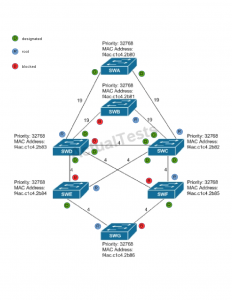During my preparation for CCIE R&S (v5) written exam, I came along the question about Spanning Tree Protocol in which certain exhibit was shown.
There are couple of questions which rely on the same exhibit, so I took some time to determine which ports will be in which state after the network converges.
The questions are:
- Which ports are forwarding traffic after STP converges?
- Which ports are in blocking state after STP converges?
- After STP converges the traffic from switch SWG to SWD takes less optimal path. What can be done to optimize the STP tree in this switched network?
With the picture above it’s easy to answer them.

Hi!!i dont umderstad why SwB-SwD port is blk, SwB is sender lower BID than SwD so port SwD-SwB should be BLK..or not?
Hi Marina,
thanks for comment. Let me try to explain it. Obviously SWA is the root bridge here (the lowest MAC address). RBID/BID is only relevant when selecting the root bridge. When it comes to putting ports in forwarding/blocking state we concentrate on following fields in BPDU:
– RPC (root path cost) – relevant in this example
– SBID (sender bridge ID) – relevant in this example
– SPID (sender port ID) – no dual links, hence – not relevant in this example,
– RPID (receiver port ID) – applies the same as for SPID
using this order.
SWD will receive BPDUs from the SWA with better RPC (root path cost) – superior BPDUs than from SWB/SWC/SWF/SWE it connects with.
SWB will receive root BPDUs from SWA through switches SWD and SWC, so it has to decide which port it should put in blocking state.
RPC in BPDUs is the same from both SWD and SWC so it will have to use next field in BPDU which is SBID (sender bridge ID). BPDU from switch SWC will win, that port will become the root port of switch SWB and other port towards switch SWD will be put in blocking state.
I hope it helped.
Cheers,
Simo
This so clear. I have been struggling to understand this for some time. Now I am good.